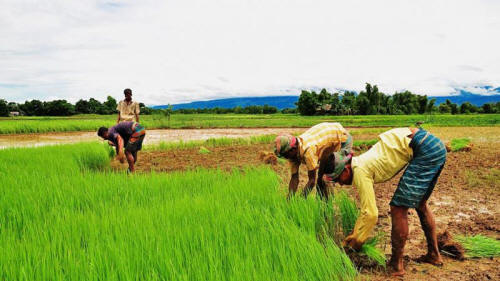What
should a productive and efficient global food system look like?
It should produce more food using
the fewest resources possible.
We need to close the
70
percent gap between the food needed to feed 9.7 billion
people by 2050 and the food produced in 2006.
Resource-efficiency is particularly crucial as competition for
water land, energy, and other resources is growing - for
example, agriculture's demand for water could rise by over 30
percent by 2030 as availability shrinks.
Additionally, per
capita arable land is expected to decrease by 50 percent by
2050.
All resources must be used more efficiently to meet
current and future needs.
Another inefficiency lies in producing
food that is not consumed - about
30
percent of food is lost or wasted every year. Improving
infrastructure, technology, transportation, and distribution
along the supply chain to reduce food loss, and educating
consumers about food waste is critical.
A new
G20
Technical Platform on Food Loss and Waste, launched by IFPRI
and FAO in 2015, will provide knowledge on best practices in
these areas.
What is an environmentally sustainable and climate-smart global
food system?
While the world's food system
contributes to about
one-fifth of global greenhouse gas (GHG) emissions, it is
conversely affected by climate change and adverse weather,
water, and soil conditions.
Global cereal yields, for example,
are projected to fall by
20 percent by 2050 due to climate change.
Therefore, an
environmentally sustainable global food system must not only
minimize negative impacts to our planet, such as land
degradation, but it must also be climate-smart. It should
integrate agricultural development, climate action, and
biodiversity conservation in order to contribute to
agro-ecological resilience.
Adoption of climate-smart approaches
- including low-carbon policies, zero-till farming, and
climate-ready crop varieties such as C4 rice - can help meet these
goals.
How can the global food system be more inclusive of poor and
marginalized groups?
Smallholder farmers, women, and
youth have important roles in ending hunger and under-nutrition
- yet they often lack access to assets and markets and are at risk
of exclusion from increasingly complex food value chains.
Maximizing the potential of commercially viable smallholder
farms, empowering women, and making agriculture more attractive
to youth can enhance their contribution to global food security
and nutrition.
This is also central to achieving other SDGs,
such as reducing inequality.
How will the global food system deliver nutritious and healthy
diets to all?
We must adopt a nutrition and
health-driven value chain approach.
While millions suffer from
hunger and under-nutrition,
641 million people globally are obese.
Pressure from
population growth, urbanization, and economic development are
leading to more intensive agricultural and industrial practices
that increase agriculture-related health and food safety risks.
The global food system must make it easier for people to consume
safe, nutritious, diverse diets in appropriate amounts, while
limiting processed foods of little nutritional value.
Interventions could include redirecting inefficient subsidies to
expand the production of nutritious crops, "cold chains" that
can help keep perishable foods fresh, taxing unhealthy foods,
and nutrition education for consumers.
What does
a business-friendly approach to the global food system mean?
It promotes well-functioning markets
and encourages entrepreneurs to adopt long-term, market-based
solutions.
Markets and trade systems need to be open,
transparent, and fair. Reducing distortions in trade policies,
such as the recent
WTO agreement to end export subsidies, is a promising step.
The private sector has a key role to play in ensuring global
food security and nutrition. Ways to increase their
participation include encouraging public-private partnerships
that link various actors along the value chain to expand profit
potential.
Creating an enabling environment is another
- adequate transportation, communications, and energy
infrastructure; and availability of financial capital can go a
long way.
If we focus our energies on these
areas, we can pave the way to achieving the SDGs on time, or
even earlier.
It may not be easy, but with all hands on deck we
can ensure a healthy, well-nourished population and a planet
that can be sustained for many generations to come.


